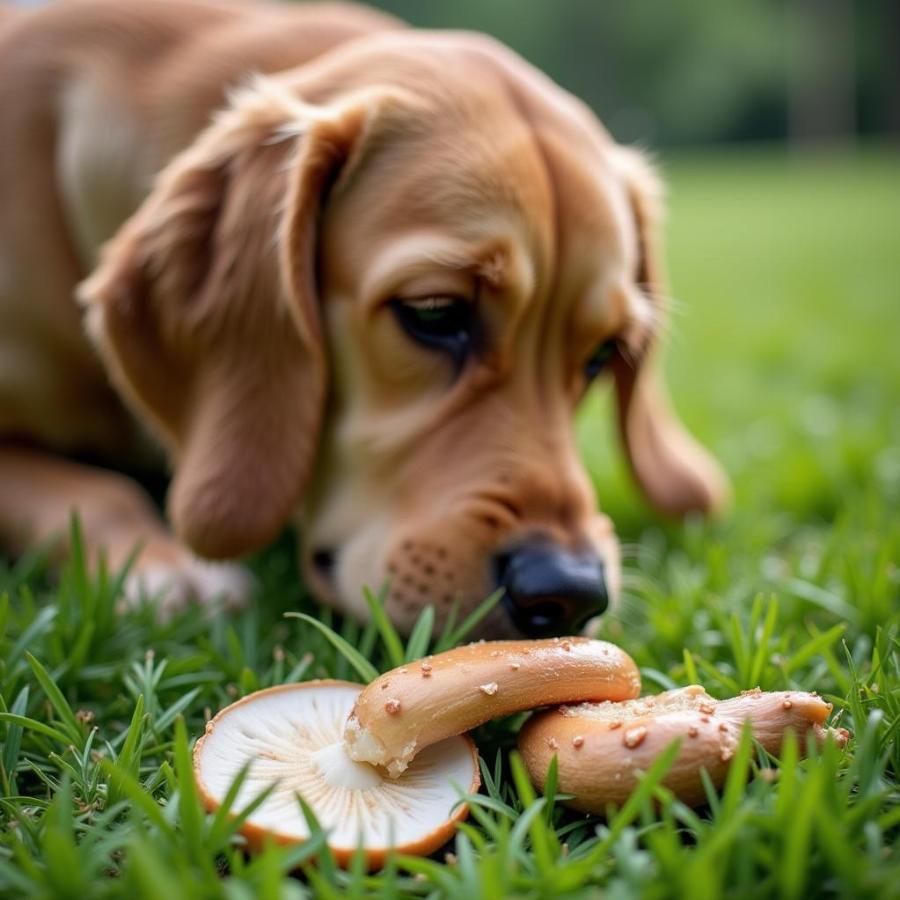If your dog just ate a mushroom in the yard, your heart is probably racing. It’s a common scenario, and understandably a frightening one. Knowing what to do quickly can make all the difference. This article will guide you through the necessary steps, from immediate action to long-term prevention.
Identifying the Mushroom: A Crucial First Step
The toxicity of mushrooms varies dramatically. While some are harmless, others can be deadly. If possible, try to collect a sample of the mushroom your dog ate. Take clear photos from different angles. Even a small piece can be helpful for identification. Note the mushroom’s location, size, color, and any distinctive features. This information will be invaluable for your veterinarian.
What Are the Signs of Mushroom Poisoning in Dogs?
Recognizing the symptoms of mushroom poisoning is key. These can appear anywhere from a few minutes to several hours after ingestion. Common signs include vomiting, diarrhea, lethargy, loss of coordination, tremors, seizures, drooling, and abdominal pain. Even seemingly mild symptoms can indicate a serious problem.
Common Symptoms to Watch For:
- Gastrointestinal Issues: Vomiting and diarrhea are often the first signs.
- Neurological Problems: Tremors, seizures, and loss of coordination indicate a more severe reaction.
- Lethargy and Weakness: Your dog might seem unusually tired or weak.
- Changes in Behavior: Look for unusual behavior like restlessness, agitation, or disorientation.
 Dog Vomiting After Eating a Mushroom in the Yard
Dog Vomiting After Eating a Mushroom in the Yard
Immediate Action: Contact Your Vet
Time is of the essence if you suspect your dog has ingested a toxic mushroom. Contact your veterinarian immediately, or if after hours, an emergency veterinary clinic. Don’t wait for symptoms to appear. The sooner treatment begins, the better the prognosis. Be prepared to provide as much information as possible about the mushroom and your dog’s condition.
Inducing Vomiting: Should You Do It?
While inducing vomiting might seem like a good idea, it’s crucial to consult your veterinarian first. In some cases, it can be beneficial, but in others, it can worsen the situation. Your vet will advise you on the best course of action based on the type of mushroom ingested and your dog’s specific circumstances. Similar to dog stinkhorn mushroom, some mushrooms can cause more damage on the way back up.
Decontamination at the Vet’s Office
Your veterinarian may perform various procedures to decontaminate your dog, such as inducing vomiting, administering activated charcoal to absorb toxins, or providing intravenous fluids to support organ function. The specific treatment will depend on the type and amount of mushroom ingested.
Preventing Future Incidents: Mushroom Control in Your Yard
The best way to protect your dog from mushroom poisoning is to prevent access to mushrooms in the first place. Regularly inspect your yard and remove any mushrooms you find. Be particularly vigilant after rain, as this encourages mushroom growth. Teach your dog the “leave it” command to deter them from investigating anything potentially harmful. This is similar to training needed to avoid weeds dangerous to dogs.
Long-Term Monitoring: After the Incident
Even after immediate treatment, it’s essential to monitor your dog closely for any lingering effects. Some toxins can cause delayed symptoms or long-term damage to organs like the liver or kidneys. Follow your veterinarian’s recommendations for follow-up care and testing. For more information on this topic, you can read our article about mushroom poisoning dogs.
Are There Any Mushrooms Safe for Dogs?
While many wild mushrooms are toxic, some store-bought mushrooms, like shiitake and portobello, can be safe for dogs in moderation. However, always cook them thoroughly and avoid adding seasonings or butter. If you’re curious about incorporating mushrooms into your dog’s diet, consult your veterinarian for guidance. You may also find our article on what kind of mushroom is good dfor dogs helpful.
Conclusion
A dog eating a mushroom in the yard can be a serious situation, but quick action and proper veterinary care can significantly improve the outcome. Being proactive in preventing mushroom access and knowing the signs of poisoning are essential for responsible dog ownership.
FAQ
- What should I do if my dog eats an unknown mushroom? Contact your veterinarian or an emergency veterinary clinic immediately.
- Are all mushrooms toxic to dogs? No, but it’s best to assume they are until identified by an expert.
- Can I induce vomiting at home? Only if instructed by your veterinarian.
- How long do mushroom poisoning symptoms take to appear? Anywhere from a few minutes to several hours.
- How can I prevent my dog from eating mushrooms? Regularly inspect and remove mushrooms from your yard and train your dog to “leave it.”
- What is the treatment for mushroom poisoning? Treatment varies depending on the type of mushroom ingested and may include inducing vomiting, administering activated charcoal, and providing supportive care.
- Can dogs eat store-bought mushrooms? Some store-bought mushrooms, like shiitake and portobello, can be safe in moderation if cooked thoroughly and unseasoned.
Beaut Dogs is your trusted source for all things dog-related, offering expert advice and valuable insights to help you provide the best possible care for your canine companion. If you need further assistance, please email us at [email protected] for detailed and accurate information. Visit Beaut Dogs for more resources and guidance on dog care.